Multisource Data Analysis for Gold Potentiality Mapping of Atalla Area and Its Environs, Central Eastern Desert, Egypt
Abstract
1. Introduction
Geology of the Study Area
2. Materials and Methods
2.1. Airborne Geophysical Data
2.1.1. Acquisition and Preparation
2.1.2. CET Grid Analysis
2.1.3. Hydrothermal Alteration Indicators
2.2. Remote Sensing Data
2.2.1. Data Characteristics and Preprocessing
2.2.2. Processing Techniques
3. Results
3.1. Analysis of Airborne Geophysical Data
3.2. Analysis of Remote Sensing Data
4. Data Integration and Validation
5. Conclusions
- The enrichment of gold mineralization is largely controlled by the weakness zones in a NW-SE trend, which forms the pathway of hydrothermal fluids.
- The interrelated datasets conclude three potential zones that need further investigation to assign their economic potential. These nominated zones have the same criteria and weight as the already confirmed gold mines within the study area.
- The combined geophysical and remote sensing data sets proved their efficacy in delivering a low-cost reliable exploration.
Author Contributions
Funding
Institutional Review Board Statement
Informed Consent Statement
Data Availability Statement
Acknowledgments
Conflicts of Interest
References
- Telford, W.M.; Geldart, L.P.; Sheriff, R.E. Applied Geophysics, 2nd ed.; Cambridge University Press: Cambridge, UK, 1990. [Google Scholar]
- Holden, E.J.; Dentith, M.; Kovesi, P. Towards the automated analysis of regional aeromagnetic data to identify regions prospective for gold deposits. Comput. Geosci. 2008, 34, 1505–1513. [Google Scholar] [CrossRef]
- Cordell, L.; Grauch, V.I.S. Mapping basement magnetitation zones from aeromagnetic data in the san juan basin, New Mexico. In Proceedings of the 1982 SEG Annual Meeting, Dallas, TX, USA, 17–21 October 1982; Society of Exploration Geophysicists: Tulsa, OK, USA, 1982; pp. 246–247. [Google Scholar]
- Miller, H.G.; Singh, V. Potential field tilt-a new concept for location of potential field sources. J. Appl. Geophys. 1994, 32, 213–217. [Google Scholar] [CrossRef]
- Cooper, G.R.J. Feature detection using sun shading. Comput. Geosci. 2003, 29, 941–948. [Google Scholar] [CrossRef]
- Wijns, C.; Perez, C.; Kowalczyk, P. Theta map: Edge detection in magnetic data. Geophysics 2005, 70, 1JA-Z68. [Google Scholar] [CrossRef]
- Youssef, M.A.S.; Elkhodary, S.T. Utilization of airborne gamma ray spectrometric data for geological mapping, radioactive mineral exploration and environmental monitoring of southeastern Aswan city, South Eastern Desert, Egypt. Geophys. J. Int. 2013, 195, 1689–1700. [Google Scholar] [CrossRef]
- Patra, I.; Veldi, R.B. High-resolution Airborne Gamma-ray Spectrometric Data in Geological Mapping-A Case Study from Parts of Shillong Basin, Meghalaya. J. Geophys. 2016, XXXVII, 173–178. [Google Scholar]
- Ahmadirouhani, R.; Karimpour, M.H.; Rahimi, B.; Malekzadeh-Shafaroudi, A.; Pour, A.B.; Pradhan, B. Integration of SPOT-5 and ASTER satellite data for structural tracing and hydrothermal alteration mineral mapping: Implications for Cu–Au prospecting. Int. J. Image Data Fusion 2018, 9, 237–262. [Google Scholar] [CrossRef]
- Pour, A.B.; Hashim, M.; Hong, J.K.; Park, Y. Lithological and alteration mineral mapping in poorly exposed lithologies using Landsat-8 and ASTER satellite data: North-eastern Graham Land, Antarctic Peninsula. Ore Geol. Rev. 2019, 108, 112–133. [Google Scholar] [CrossRef]
- Van der Werff, H.; van der Meer, F. Sentinel-2A MSI and Landsat 8 OLI Provide Data Continuity for Geological Remote Sensing. Remote Sens. 2016, 8, 883. [Google Scholar] [CrossRef]
- Zoheir, B.; El-Wahed, M.A.; Pour, A.B.; Abdelnasser, A. Orogenic gold in transpression and transtension zones: Field and remote sensing studies of the barramiya—mueilha sector, Egypt. Remote Sens. 2019, 11, 2122. [Google Scholar] [CrossRef]
- Hunt, G.R.; Ashley, R.P. Spectra of altered rocks in the visible and near infrared. Econ. Geol. 1979, 74, 1613–1629. [Google Scholar] [CrossRef]
- Hamimi, Z.; Hagag, W.; Kamh, S.; El-Araby, A. Application of remote-sensing techniques in geological and structural mapping of Atalla Shear Zone and Environs, Central Eastern Desert, Egypt. Arab. J. Geosci. 2020, 13. [Google Scholar] [CrossRef]
- Abd el Monsef, M. Ore Controls and Metallogenesis of Au-Ag Deposits at Atalla Mine, Central Eastern Desert of Egypt. Acta Geol. Sin.English Ed. 2020, 94, 1451–1470. [Google Scholar] [CrossRef]
- CONOCO (Continental Oil Company). Geological map of Egypt (Scale 1: 500,000); CONOCO Inc.: Ogden, UT, USA, 1987; in Collaboration with Freie Universitat Berlin, Berlin, Germany. [Google Scholar]
- Spector, A.; Grant, F.S. Statistical models for interpreting aeromagnetic data. Geophysics 1970, 35, 293–302. [Google Scholar] [CrossRef]
- Moxham, R.M.; Foote, R.S.; Bunker, C.M. Gamma-ray spectrometer studies of hydro-thermally altered rocks. Econ. Geol. 1965, 60, 653–671. [Google Scholar] [CrossRef]
- Shives, R.B.K.; Charbonneau, B.W.; Ford, K.L. The detection of potassic alteration by gamma-ray spectrometry—Recognition of alteration related to mineralization. Geophysics 2000, 65, 2001–2011. [Google Scholar] [CrossRef]
- Saunders, D.F.; Terry, S.A.; Thompson, C.K. Test of National Uranium Resource Evaluation gamma-ray spectral data in petroleum reconnaissance (Texas). Geophysics 1987, 52, 1547–1556. [Google Scholar] [CrossRef]
- César, A.; Pires, B. IDENTIFICAÇÃO GEOFÍSICA DE ÁREAS DE ALTERAÇÃO HIDROTERMAL, CRIXÁS-GUARINOS, GOIÁS. Braz. J. Geol. 2017, 25, 61–68. [Google Scholar]
- Yamaguchi, Y.; Fujisada, H.; Tsu, H.; Sato, I.; Watanabe, H.; Kato, M.; Kudoh, M.; Kahle, A.B.; Pniel, M. ASTER early image evaluation. Adv. Sp. Res. 2001, 28, 69–76. [Google Scholar] [CrossRef]
- Drusch, M.; Del Bello, U.; Carlier, S.; Colin, O.; Fernandez, V.; Gascon, F.; Hoersch, B.; Isola, C.; Laberinti, P.; Martimort, P. Sentinel-2: ESA’s optical high-resolution mission for GMES operational services. Remote Sens. Environ. 2012, 120, 25–36. [Google Scholar] [CrossRef]
- Abd El-Wahed, M.; Kamh, S.; Ashmawy, M.; Shebl, A. Transpressive Structures in the Ghadir Shear Belt, Eastern Desert, Egypt: Evidence for Partitioning of Oblique Convergence in the Arabian-Nubian Shield during Gondwana Agglutination. Acta Geol. Sin. English Ed. 2019, 93, 1614–1646. [Google Scholar] [CrossRef]
- Manuel, R.; Brito, M.D.G.; Chichorro, M.; Rosa, C. Remote sensing for mineral exploration in central Portugal. Minerals 2017, 7, 184. [Google Scholar] [CrossRef]
- Pour, A.B.; Park, T.Y.S.; Park, Y.; Hong, J.K.; Zoheir, B.; Pradhan, B.; Ayoobi, I.; Hashim, M. Application of multi-sensor satellite data for exploration of Zn-Pb sulfide mineralization in the Franklinian Basin, North Greenland. Remote Sens. 2018, 10, 1186. [Google Scholar] [CrossRef]
- Noori, L.; Pour, A.B.; Askari, G.; Taghipour, N.; Pradhan, B.; Lee, C.W.; Honarmand, M. Comparison of different algorithms to map hydrothermal alteration zones using ASTER remote sensing data for polymetallic Vein-Type ore exploration: Toroud-Chahshirin Magmatic Belt (TCMB), north Iran. Remote Sens. 2019, 11, 495. [Google Scholar] [CrossRef]
- Masoud, A.; Koike, K. Applicability of computer-aided comprehensive tool (LINDA: LINeament Detection and Analysis) and shaded digital elevation model for characterizing and interpreting morphotectonic features from lineaments. Comput. Geosci. 2017, 106, 89–100. [Google Scholar] [CrossRef]
- El-Magd, I.A.; Mohy, H.; Basta, F. Application of remote sensing for gold exploration in the Fawakhir area, Central Eastern Desert of Egypt. Arab. J. Geosci. 2015, 8, 3523–3536. [Google Scholar] [CrossRef]
- Elkhateeb, S.O.; Abdellatif, M.A.G. Delineation potential gold mineralization zones in a part of Central Eastern Desert, Egypt using Airborne Magnetic and Radiometric data. NRIAG J. Astron. Geophys. 2018, 7, 361–376. [Google Scholar] [CrossRef]
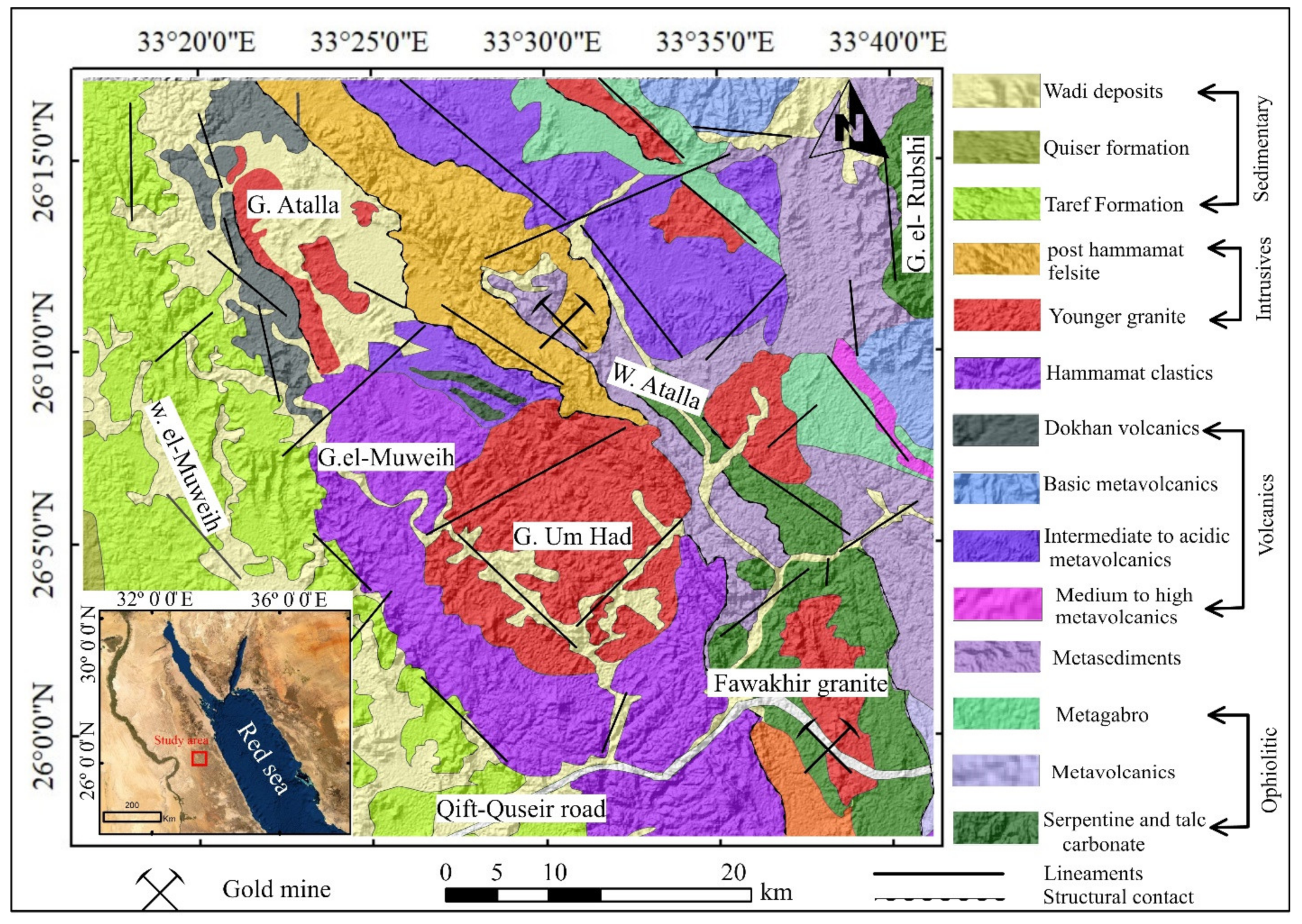
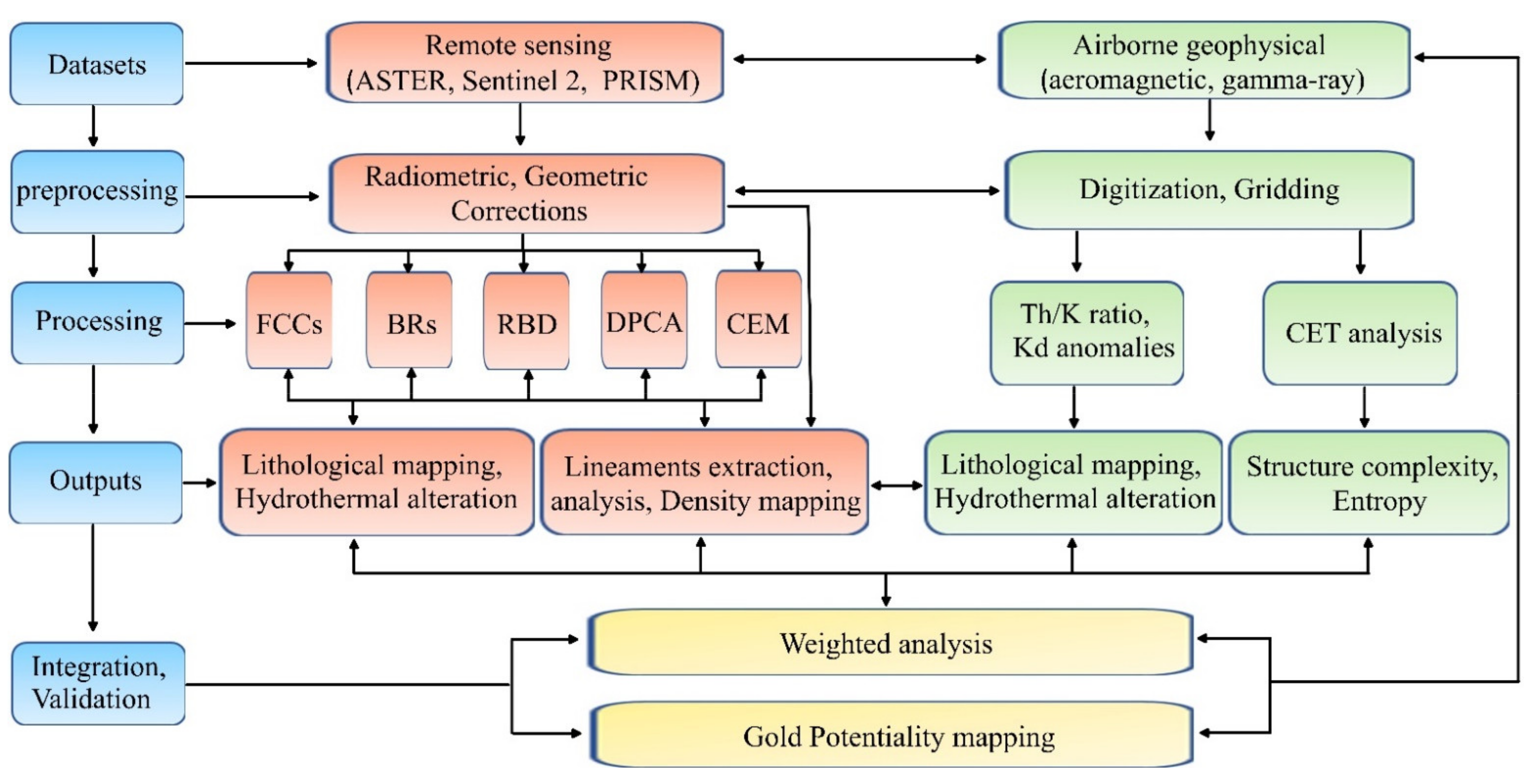
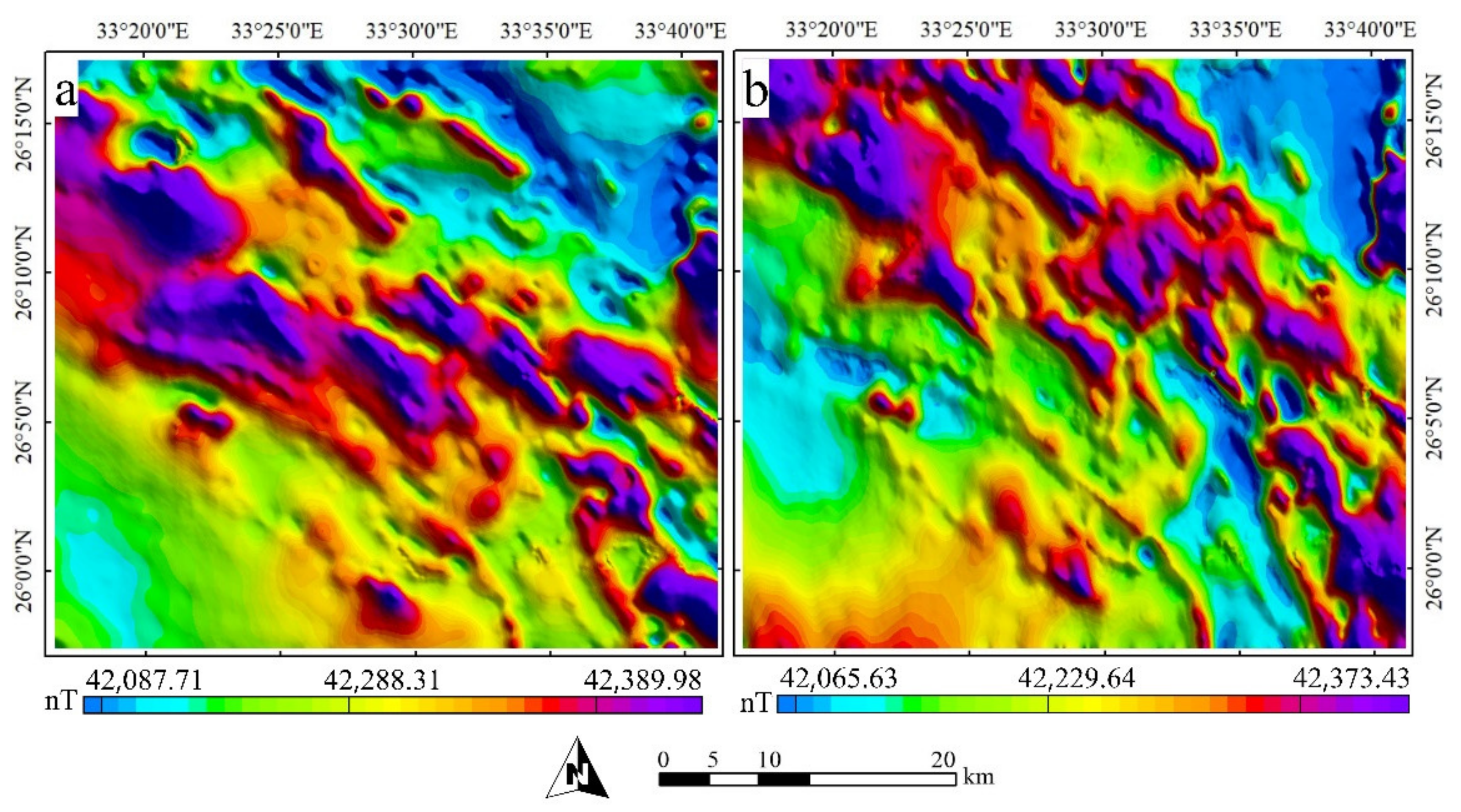
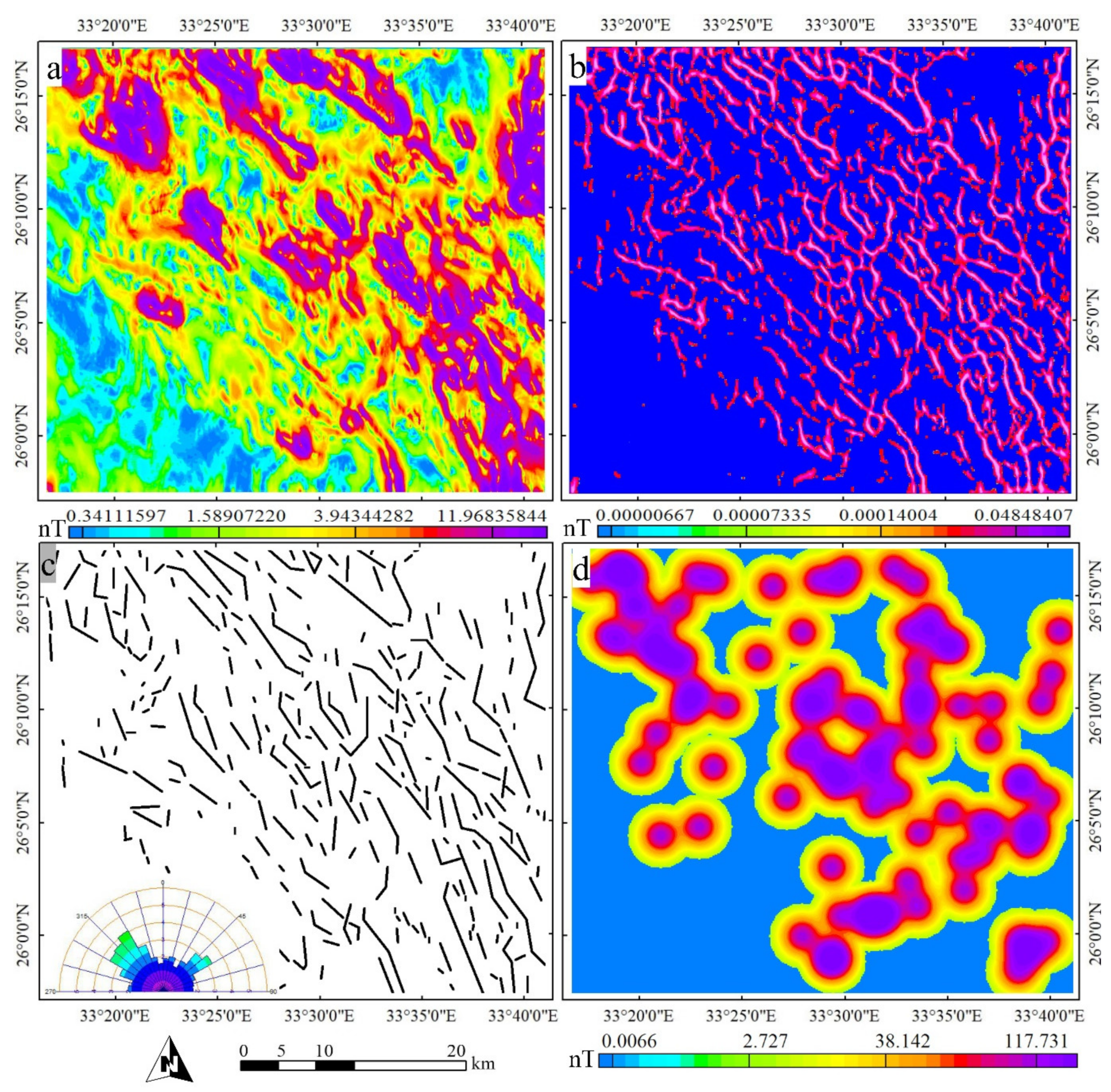
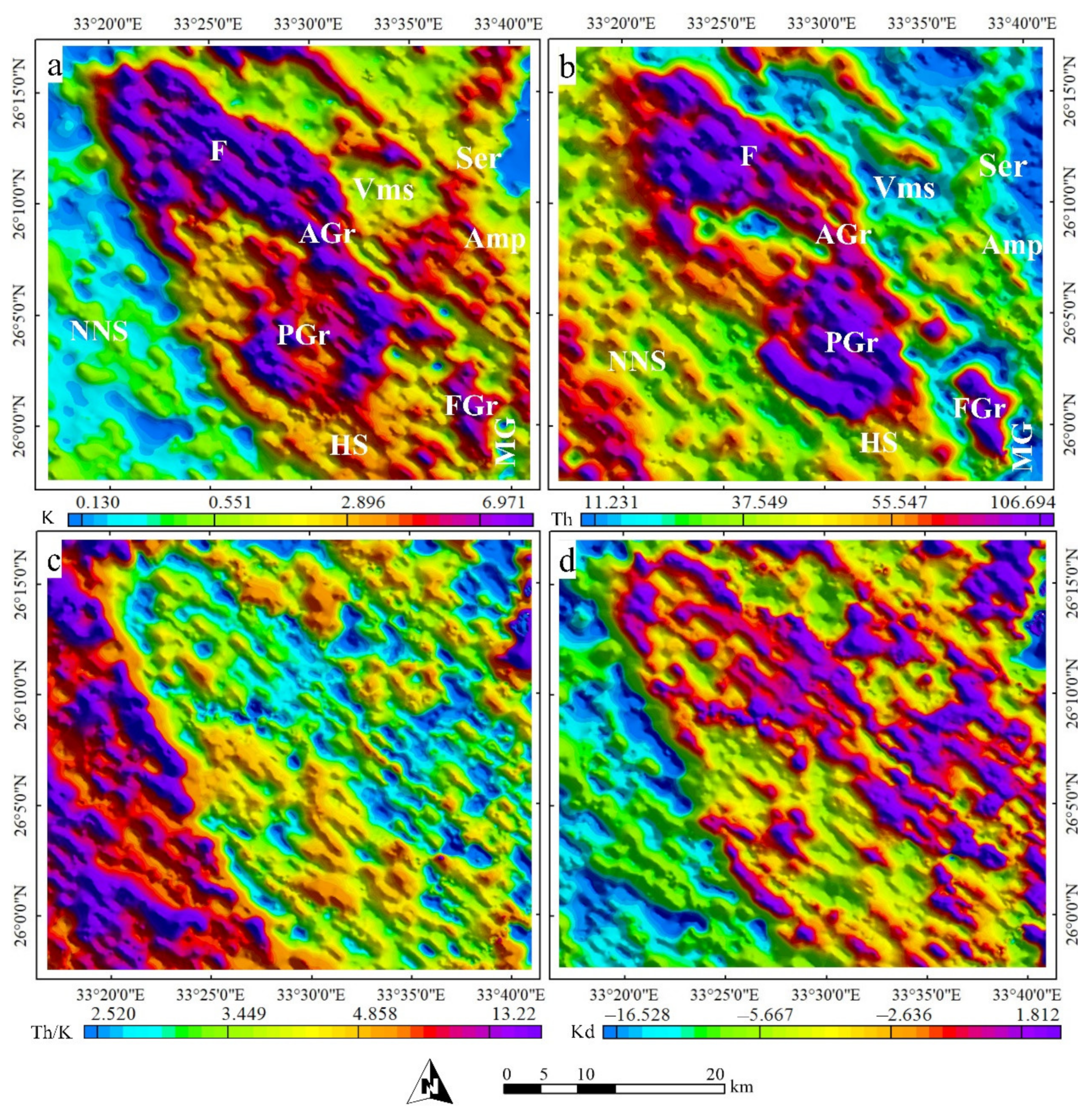
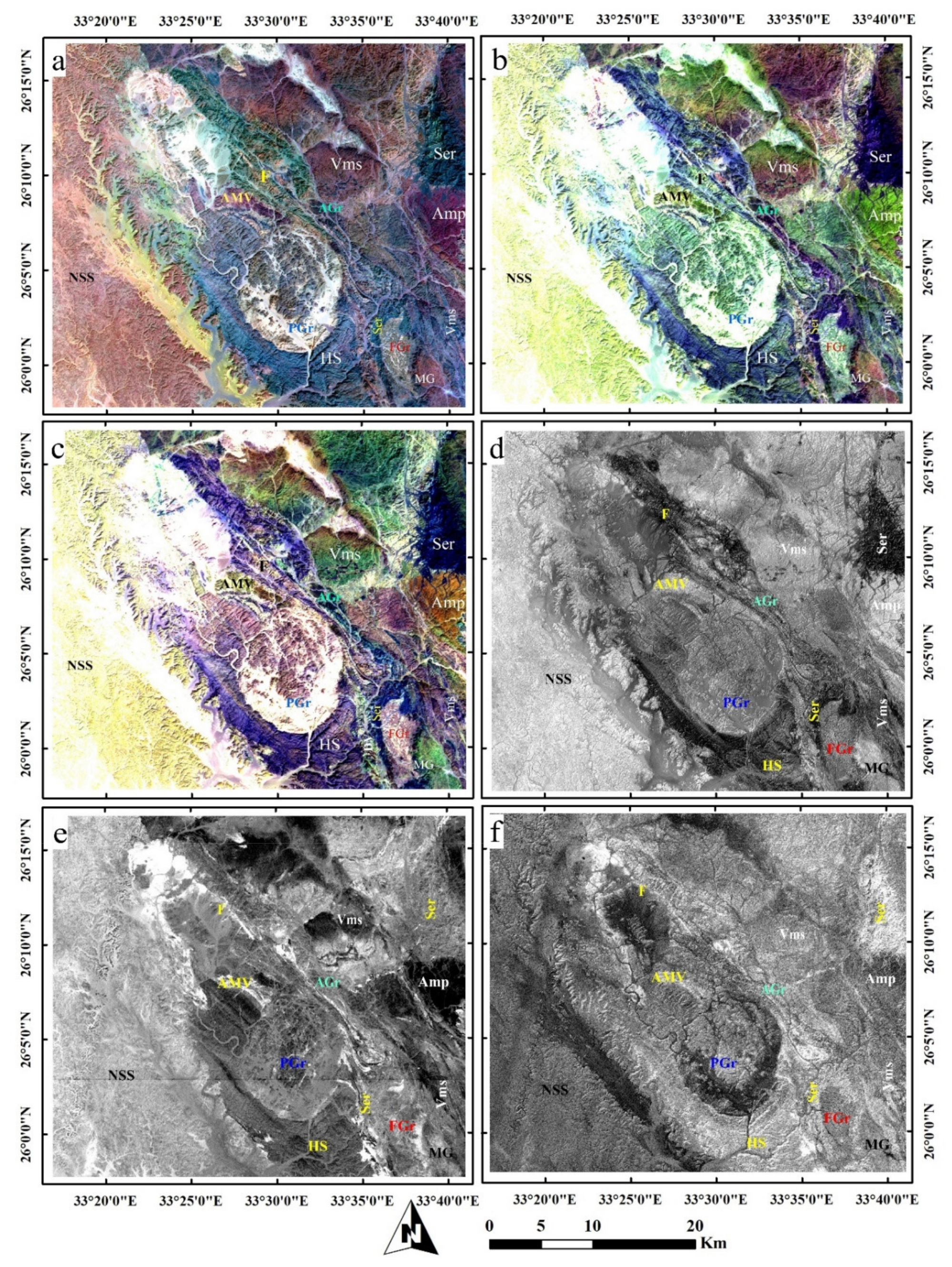
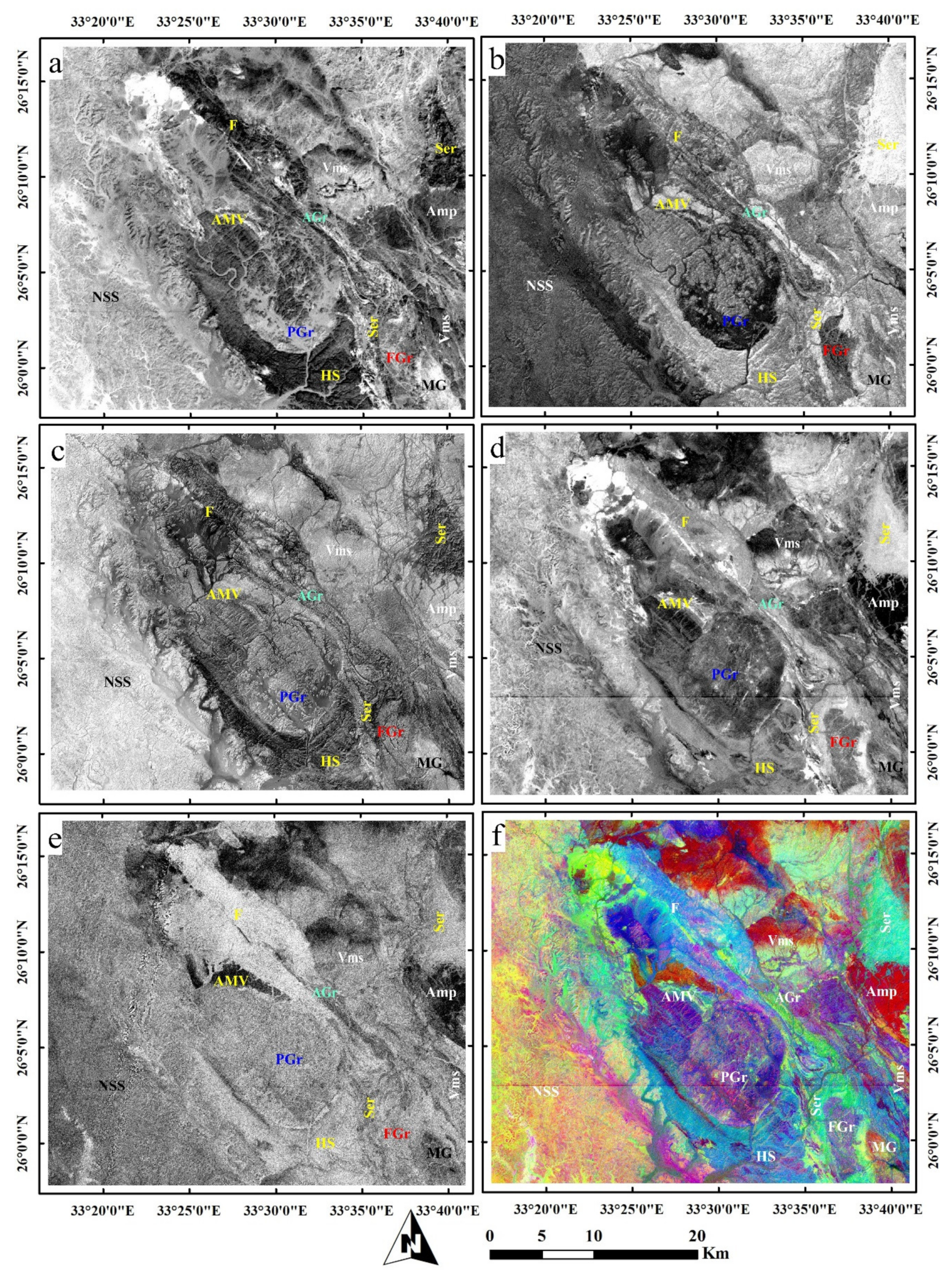
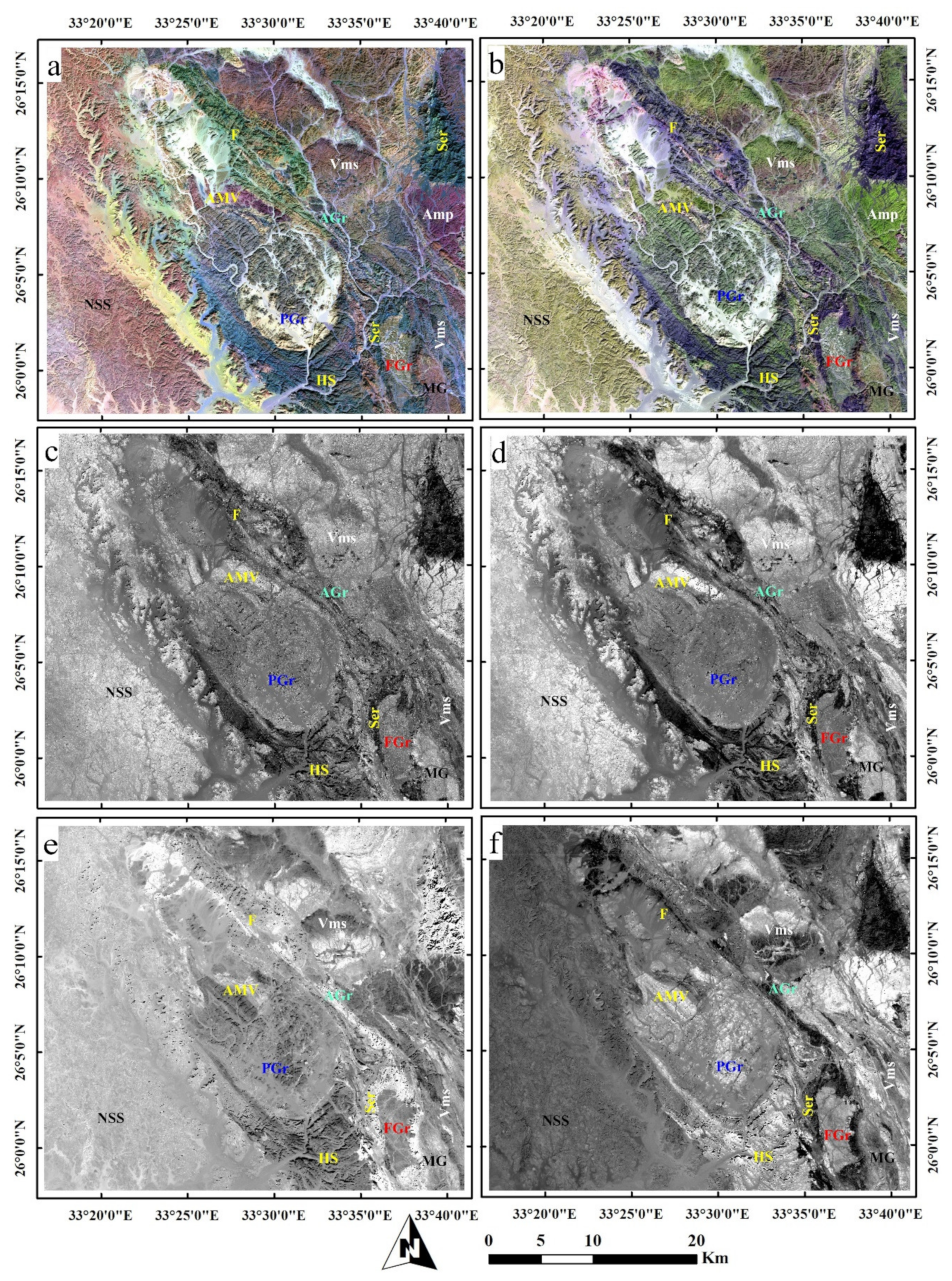
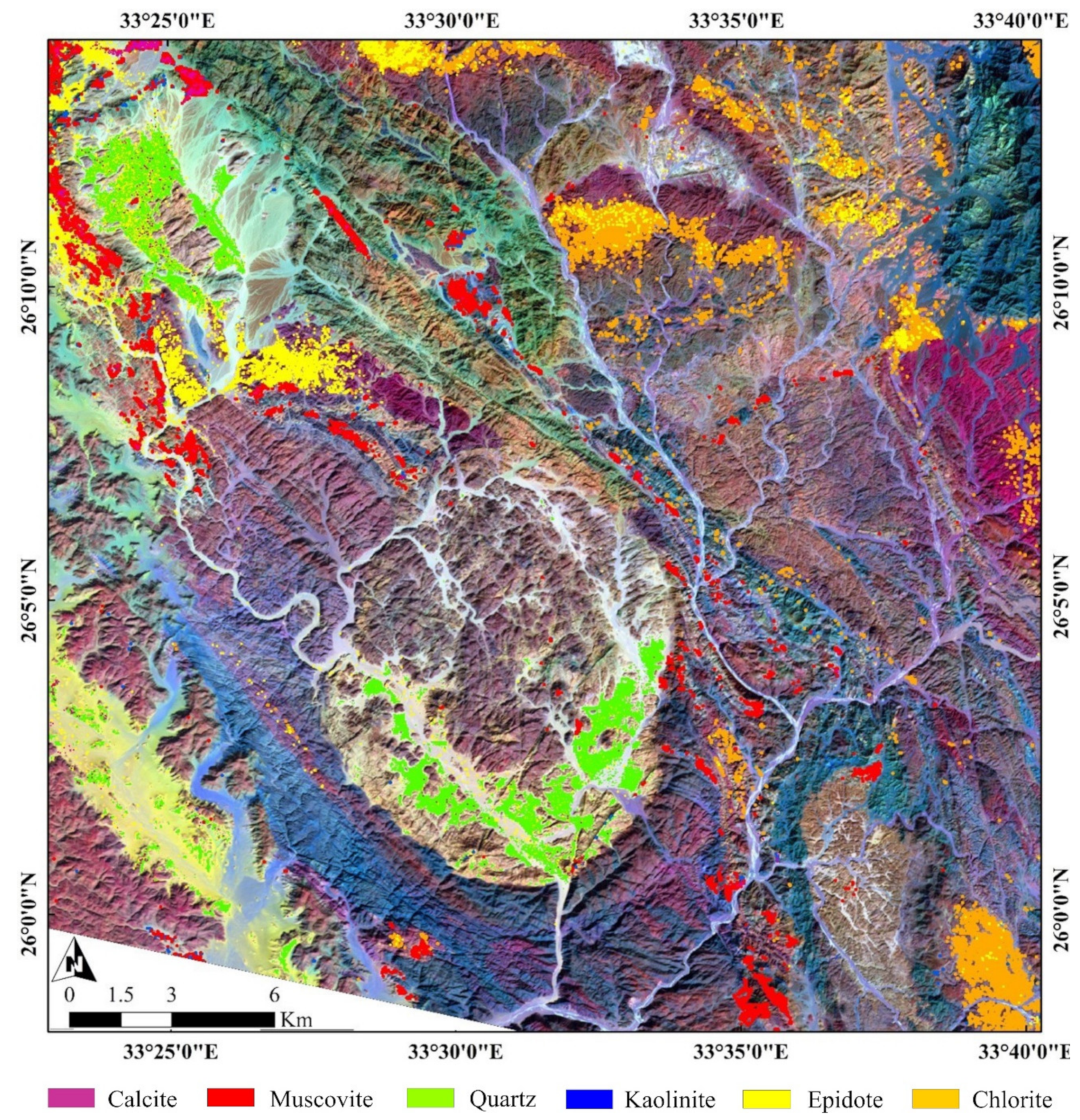
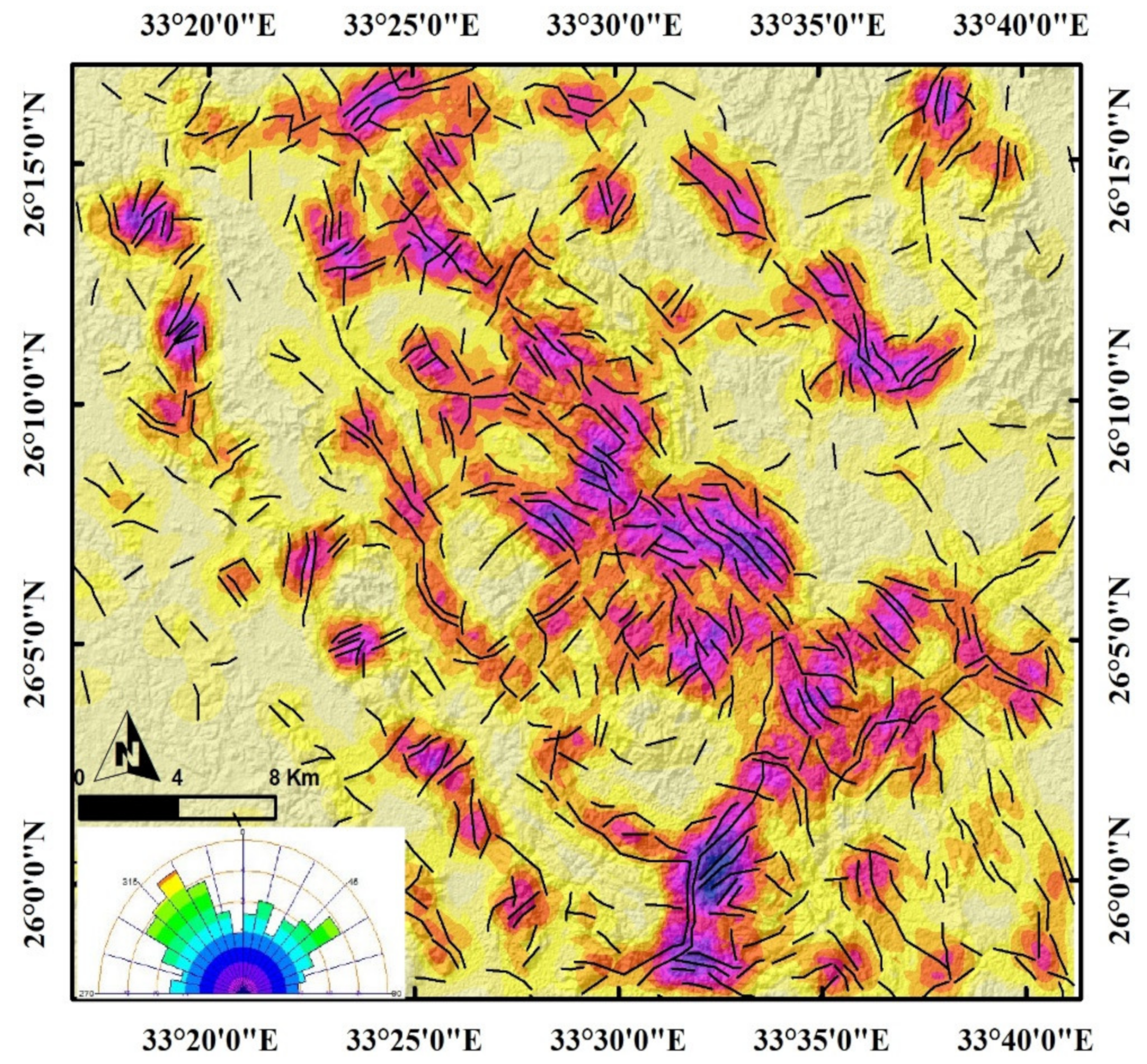
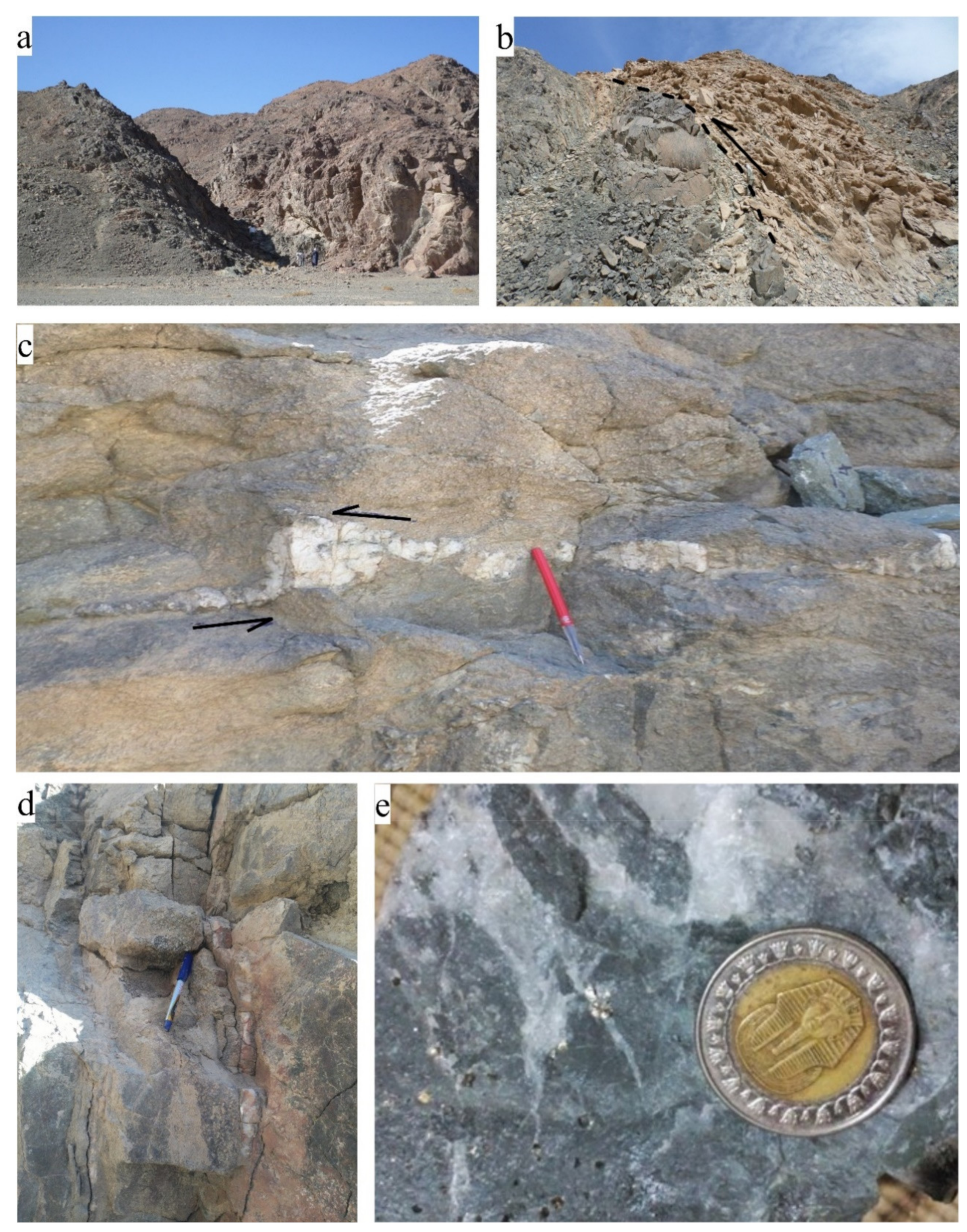
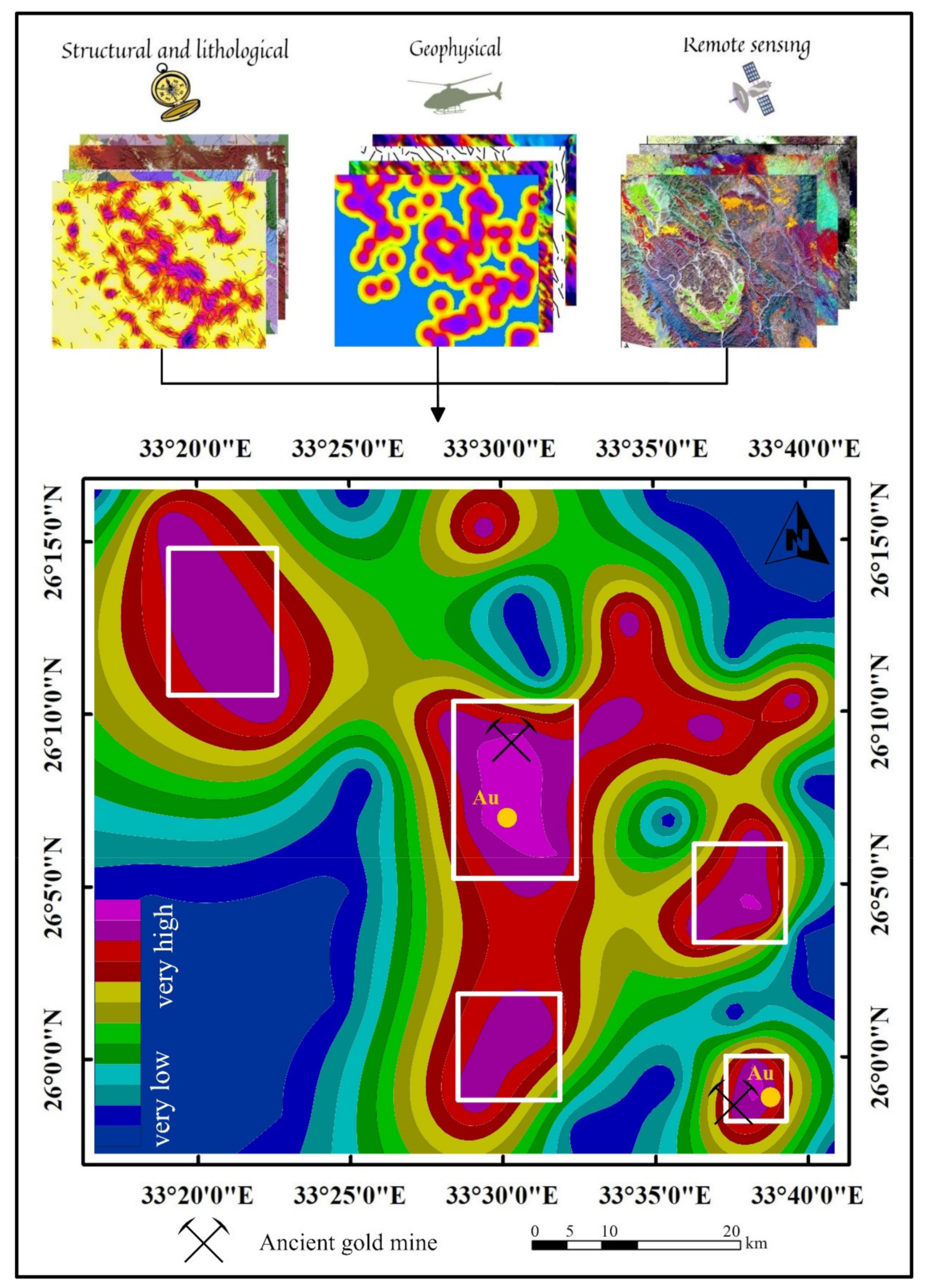
| ASTER | Sentinel 2 | ||||
|---|---|---|---|---|---|
| Band (b) | Central Wavelength (µm) | Pixel Size (m) | Band (b) | Central Wavelength (µm) | Pixel Size (m) |
| 1 | 0.560 | 15 | 1 | 0.443 | 60 |
| 2 | 0.660 | 15 | 2 | 0.490 | 10 |
| 3N | 0.820 | 15 | 3 | 0.560 | 10 |
| 3B | 0.820 | 15 | 4 | 0.665 | 10 |
| 4 | 1.650 | 30 | 5 | 0.704 | 20 |
| 5 | 2.165 | 30 | 6 | 0.740 | 20 |
| 6 | 2.205 | 30 | 7 | 0.782 | 20 |
| 7 | 2.260 | 30 | 8 | 0.842 | 10 |
| 8 | 2.330 | 30 | 8a | 0.865 | 20 |
| 9 | 2.395 | 30 | 9 | 0.945 | 60 |
| 10 | 1.375 | 60 | |||
| 11 | 1.610 | 20 | |||
| 12 | 2.190 | 20 | |||
| Iron Oxides/Hydroxides Minerals | Argillic Alteration | Propylitic Alteration | |||||||||
|---|---|---|---|---|---|---|---|---|---|---|---|
| A | Band 1 | Band 2 | Band 4 | B | Band 4 | Band 5 | Band 6 | C | Band 7 | Band 8 | Band 9 |
| PC1 | −0.309 | −0.532 | −0.787 | PC1 | 0.573 | 0.580 | 0.578 | PC1 | −0.514 | −0.532 | −0.672 |
| PC2 | −0.493 | −0.618 | 0.611 | PC2 | 0.809 | −0.295 | −0.506 | PC2 | −0.491 | −0.459 | 0.739 |
| PC3 | −0.8129 | 0.577 | −0.0713 | PC3 | 0.122 | −0.758 | 0.639 | PC3 | −0.702 | 0.712 | −0.025 |
Publisher’s Note: MDPI stays neutral with regard to jurisdictional claims in published maps and institutional affiliations. |
© 2021 by the authors. Licensee MDPI, Basel, Switzerland. This article is an open access article distributed under the terms and conditions of the Creative Commons Attribution (CC BY) license (https://creativecommons.org/licenses/by/4.0/).
Share and Cite
Shebl, A.; Abdellatif, M.; Elkhateeb, S.O.; Csámer, Á. Multisource Data Analysis for Gold Potentiality Mapping of Atalla Area and Its Environs, Central Eastern Desert, Egypt. Minerals 2021, 11, 641. https://doi.org/10.3390/min11060641
Shebl A, Abdellatif M, Elkhateeb SO, Csámer Á. Multisource Data Analysis for Gold Potentiality Mapping of Atalla Area and Its Environs, Central Eastern Desert, Egypt. Minerals. 2021; 11(6):641. https://doi.org/10.3390/min11060641
Chicago/Turabian StyleShebl, Ali, Mahmoud Abdellatif, Sayed O. Elkhateeb, and Árpád Csámer. 2021. "Multisource Data Analysis for Gold Potentiality Mapping of Atalla Area and Its Environs, Central Eastern Desert, Egypt" Minerals 11, no. 6: 641. https://doi.org/10.3390/min11060641
APA StyleShebl, A., Abdellatif, M., Elkhateeb, S. O., & Csámer, Á. (2021). Multisource Data Analysis for Gold Potentiality Mapping of Atalla Area and Its Environs, Central Eastern Desert, Egypt. Minerals, 11(6), 641. https://doi.org/10.3390/min11060641








